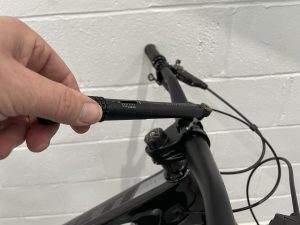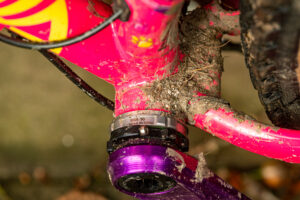The toughest tyres for your e-bike, the grippiest compounds for enduro or downhill, and the fastest rolling rubber for XC and down-country: we've got the best tyres for all situations
Tyre tech has gone ballistic in recent years, with new rubber compounds, carcass designs, tread patterns and new brands entering the mountain bike space. That’s great because the choice has never been better, but it can be confusing to say the least… and an expensive mistake if you get it wrong.
That’s why we’ve tested pretty much every tyre going, from the best mountain bike mud tyres to the quickest rolling rears, to produce THE definitive list of recommended rubber. We’ve split this guide into three parts to make things easier, with rubber for e-bikes or enduro use, tyres for lighter bikes like XC or down-country rigs, and full on gravity or downhill tyres for maximum grip. You’ll want something to get them set up too, so check out our guide to the best mountain bike tubeless inflators and floor pumps.
Best mountain bike tyres – quick list
- Best all round tyre – Maxxis Assegai
- Best mud tyre – Specialized Hillbilly Grid Gravity T9
- Best budget front tyre – Specialized Butcher Grid T9 tyre
- Best budget tyre for e-bikes – E*thirteen Grappler Enduro MoPo tyre
Best mountain bike tyres: enduro and e-bike

The Maxxis Assegai is the best all round mountain bike tyre, it works predictably in almost all conditions and rolls well too
1. Maxxis Assegai tyre
Best all-round mountain bike tyre
Weight: 1,330g | Size tested: 29 x 2.5in | Actual size: N/A | Rating: 10/10
Reasons to buy:
- Great at hard cornering
- Perfect blend of grip, damping and rolling speed
Reasons to avoid:
- Not light
- Can be draggy if you get the MaxxGrip softer compound
Maxxis broke the mould when it invented the Assegai. It’s our favourite front tyre right now, because it’s miraculously able to do everything right, delivering high levels of grip in pretty much all conditions. From dust to mud, roots to rocks, the Assegai is never overwhelmed and lets you get on with the job of riding your bike.
Which compound should you go for? That’s always a tricky question with tyres because they come in so many different variants, but the 3C Maxx Terra, EXO+ version is our pick. It uses a reinforced, single-ply, construction, and slightly harder rubber compound, which means it rolls well but still generates great traction.
The Achilles heel? Thick mud can choke it, but of course then you’ll want to switch to the best mud tyre out there. Until that happens, it’s the tyre 90% of us should be riding.
Read our full test review of Maxxis Assegai tyre

The Specialized Butcher T9 is hands-down the best value front tyre on the market.
2. Specialized Butcher Grid T9 tyre
Best budget front tyre
Weight: 1,060g | Size tested: 29 x 2.3in | Sizes: 27.5/29in x 2.3/2.6in | Actual size: 61mm | Rating: 9/10
Reasons to buy:
- Excellent damping and control
- Springy casing
Reasons to avoid:
- Cold, wet conditions are its nemesis
Given that you can pick up this tyre for less than £40, and it’s often on sale, the Specialized Butcher is our number one recommendation for a front tyre on a budget. But it’s not just the price that stands out. When we tested it we raved about the “sensational damping characteristics” and “superlative, ground-hugging, squelchy control”.
Older versions suffered from rubber that was too hard and pingy, and a soft casing that folded over too easily, but the new Grid casing and T9 compound are up there with the best, at half the price.
Read our full test review of Specialized Butcher Grid T9 tyre

The Specialized Eliminator T7 rolls quick and brakes reasonably well, plus it’s not pricey so you won’t mind scrubbing it off on the eeb
3. Specialized Eliminator Grid T7 tyre
Best value rear tyre
Weight: 955g | Size tested: 29 x 2.3in | Sizes: 27.5/29in x 2.3/2.6in | Actual size: N/A | Rating: 9/10
Reasons to buy:
- Excellent value
- Fast rolling
- Works great as a rear tyre
Reasons to avoid:
- Not the best cornering grip
The Specialized Eliminator is a cracking rear tyre for enduro or e-bike use. That’s thanks to its great inflated shape that delivers a seamless transition between leant over cornering grip and upright rolling speed.
The casing is tough and supportive too, just what you need on a rear tyre, and the braking performance is surprisingly good. Couple that with quick rolling speed and a price that’s literally half that of the competition and you have our favourite budget rear tyre.
Read our full test review of Specialized Eliminator Grid T7 tyre

The Continental Kryptotal is like a drug, drip feeding you grip that you just can’t give up on
4. Continental Kryptotal Enduro R Soft tyre
Best tyre for pure grip
Weight: 1,080g | Size tested: 29 x 2.4in | Actual size: N/A | Rating: 9/10
Reasons to buy:
- Grip is superb
- Stiff casing lets you run lower pressures
- Decent rolling speed
Reasons to avoid:
- Not available in a lighter casing – yet
The Continental Kryptotal is an addictive tyre, it hooks you on ridiculous levels of grip it’s hard to go back to anything else. Primarily designed for mixed conditions, it’s part of Continental’s resurgence and represents one of the best new tyres we’ve seen in years.
The Kryptotal is end-specific, meaning there’s a rear with fat ramped central lugs for braking, and a front option with squarer central knobs to bite into the trail. Both feel calm and planted, sticky almost, and take vibrations and small chatter out of the trail all without dulling the experience. Welcome back, Conti.
Read our full test review of Continental Kryptotal Enduro R Soft tyre

The Maxxis Minion DHRII is a brilliant rear tyre, prioritising braking traction and rolling speed, but can also be used up front.
5. Maxxis Minion DHR II tyre
Best rear tyre for mixed conditions (and great up front)
Weight: 1,010g | Size tested: 29 x 2.4in | Actual size: 60.4mm | Rating: 10/10
Reasons to buy:
- Excellent grip without excess drag
- It works really well on the front too!
Reasons to avoid:
- Multiple versions can be confusing (get 3C MaxxTerra for rear tyre)
- Slightly undersized compared to other beefier brands
The DHR II is the best rear tyre on the market right now. With big lugs running perpendicular to the trail it’s excellent at scrubbing off speed, and there’s enough space between them to shed loam and avoid becoming choked up and encased in slippy mud.
Bizarrely then, it also works great as a front tyre, the chunky tetris-shaped side lugs and heavily siped square knobs alternate to find grip in mixed and loose conditions, and the DHR II generates good grip without the Assegai weight penalty.
Read our full test review of Maxxis Minion DHR II tyre

6. E*thirteen Grappler Enduro MoPo tyre
Best value enduro / e-bike tyre
Weight: 1,040g | Size tested: 29 x 2.4in (also available in 27.5 x 2.5in) | Actual size: N/A | Rating: 10/10
Reasons to buy:
- Excellent sticky compound, great grip, impressive damping
Reasons to avoid:
- Er, do we have to put something here? It’s basically faultless.
Even in the toughest conditions, from wet to dry, rocky to loamy, the extra sticky MoPo rubber blend will blow you away with its grip. The secret formula lets the tyre’s lugs conform to the trail with poise and regularity, producing oodles of confidence. This seems to be true of any surface, from greasy dirt to rocks and roots.
Grappler is available in two casing and compound options, including a thick dual ply version designed for DH and enduro racing on the hardest tracks in the world. You don’t need race team funding to get the Grappler either, its surprisingly good value.
Read our full test review of the E*thirteen Grappler Enduro MoPo tyre
 6. Specialized Hillbilly Grid Gravity T9
6. Specialized Hillbilly Grid Gravity T9
Best value mud tyre
Weight: 1,360g | Size tested: 29 x 2.4in | Rating: 10/10
Reasons to buy:
- The excellent price
- Works great on slimy roots and rocks as well as loose mud
- Fine in drier conditions too
- Tough and durable
Reasons to avoid:
- One of the heaviest DH/Enduro mud tyres around
- Slower rolling than some similar tyres
Specialized tyres are great value, and that tradition continues with the Hillbilly, which is around a third less than the competition. That doesn’t stop it laying down some serious grip though, it’s heavy and slow rolling for sure, but its ability to slice through mud is unmatched.
The lugs are tall enough to dig into all but the deepest mud, but they’re well supported enough to find grip on hard surfaces like rock too. In fact, the Hillbilly manages to work well in dry conditions too, although the slow rolling speed will soon force a swap out once the trails dry out.
Read review of the Specialized Hillbilly Grid Gravity T9
Best mountain bike tyres: XC trail and down-country

Maxxis came up with a better sequel in the Forekaster II, it’s got great grip but now you get comfort and support too
1. Maxxis Forekaster II 3C Maxx Terra tyre
Best down-country or light trail tyre
Weight: 940g | Size tested: 29 x 2.4in | Actual size: NA | Rating: 10/10
Maxxis has made some great changes to the Forekaster, it was always grippy but now there’s extra volume in the carcass to add a touch of comfort to shorter travel bikes. The lugs themselves have grown in stature too, adding more grip than ever.
It’s super quick rolling, making it ideal for down-country bikes, with rocket fast rolling speed and acceleration to match an F1 car. It’s very much XC in feel then, but punches way above its weight, quite literally, and it works just as well in the wet as it does in the dry.
Reasons to buy
- Comfortable ride with better damping than the old version
- Grip in all conditions, ideal for all-year riding
- Quick rolling and easy to accelerate or change direction
- Decent puncture protection for an XC tyre
Reasons to avoid
- There are faster rolling tyres out there for racing
- It’s not cheap
Read our full test review of the Maxxis Forekaster II 3C Maxx Terra tyre

The Purgatory is an absolute steal, loads of grip and cush but without the silly money pricetagSpecialized Purgatory Grid 2Bliss T7 tyre
2. Specialized Purgatory Grid 2Bliss T7 tyre
Best value trail bike tyre
Weight: 835g | Size tested: 29 x 2.3in | Actual size: NA | Rating: 9/10
The Purgatory has been updated with Specialized’s latest T rubber, and that helps it achieve more cornering grip and better braking traction than ever before. It’s an out and out trail tyre, but now with a performance boost ideal for more aggressive riders and higher speeds.
It’s a stable ride too, there’s little bounciness considering its low 800g weight, and it won’t skip and buck over rough terrain like the Schwalbe Wicked Will or Nobby Nic. Both those tyres kill it for pace, while the Maxxis Dissector has better side protection, but none can rival the ridiculous price of the Purgatory.
Reasons to buy:
- Latest T7 rubber has good grip and brilliant damping
- Composed and grippy on rough terrain, one of the best lightweight tyres out there
- Cheap as chips, you can buy three of them to something from Maxxis or Schwalbe
Reasons to avoid:
- Sidewall can lack support when you’re really hauling
Read our full review of the Specialized Purgatory Grid 2Bliss T7 tyre review
Best mountain bike tyres: DH and gravity riding

Schwalbe’s Albert Radial tyre is a game changer, adding comfort and control all without adding a ton of weight
1. Schwalbe Albert Radial Gravity Pro
Best downhill tyre
Weight: 1,310g | Size tested: 29 x 2.5in | Actual size: 62mm | Rating: 10/10
Schwalbe’s new Radial tyre is at the cutting edge of our sport, pun intended. It relies on a new casing that reduces overlap and makes for a more forgiving and supple tyre out on the trails. Grip levels are really high thanks to the bigger contact patch inherent in this new design.
I found the Abert Radial really did reduce the buzz from chunky terrain, taking hits like a champ and bouncing back with so much control. The comfort and squishiness is next level, the carcass deforming to such a level I had to add more air pressure to get that regular tyre feel I’m used to.
Reasons to buy:
- Grippiest and most controlled DH tyre out there
- Superb damping and calmness from the supple carcass
- Great connection with the trail, good feel without the harshness
- Lighter and faster rolling than many other DH tyres
Reasons to avoid:
- Expensive
- Lack of pronounced shoulder blocks for high lean angles
- Slower to clear mud than the Maxxis Assegai
Read our full test review of the Schwalbe Albert Radial Gravity Pro

The Schwalbe Tacky Chan is all about speed, it’ll gain you crucial seconds between the tape thanks to its fast acceleration and cornering grip
2. Schwalbe Tacky Chan tyre
Best gravity race tyre
Weight: 1,340g | Size tested: 29 x 2.4in | Actual size: 60mm | Rating: 9/10
Reasons to buy:
- Huge edge grip levels for cornering when loaded
- Fast rolling for a DH tyre
- Good muck clearing and braking bite
Reasons to avoid:
- Wears out fast in Addix Ultra Soft.
- Extreme precision wouldn’t suit everyone.
- Expensive, with spec options between £68.99 – £74.99
The Tacky Chan is all about speed, it’s available in 2.4in only across 27.5in and 29er wheels to lessen drag, all the while keeping extraordinary levels of grip when loaded into the corners. That makes it spot on if you’re going racing, it’ll gain you a few extra seconds when pushed to the limits, something that’s hard to put a price on.
Just don’t expect much comfort from the Tacky Chan, it’s lighter and quicker than the Schwalbe Magic Mary, accelerates like lightening, but you’ll feel it on the rough stuff.
Read our full test review of the Schwalbe Tacky Chan tyre

Michelin’s DH22 is a cracking downhill tyre for racing, it’s reliable and grippy but still a shade too slow and heavy
Other tyres to consider:
Early in 2024 Michelin updated its gravity tyre range – the French brand had always been strong on grip and protection but its offerings out-weighed the competition by some margin. The latest Michelin DH22 Racing Line tyre goes some way to address this, slicing a good chunk off its weight with a lighter casing and claiming better performance in subzero conditions too. When we reviewed it we liked that you could now fold the tyre for better storage, and the grip levels are simply out of this world. And try as we might, puncturing the things proved impossible. It’s hard to make it into our best tyres guide though because there are just so many good options out there, and ultimately the DH22 is still just a smidge over weight.
Michelin also updated its enduro tyres with the same goal, to reduce weight and drag. The Michelin Wild Enduro MS Racing Line does definitely roll faster than the previous model, we found, while the carcass still remained stable and sure footed even at lower pressures. It wasn’t all about the new casings though, the tread pattern has been completely changed and now features a more regular shoulder pattern without gaps for more consistent grip when you’re lent right over. It’s a geat tyre for dependability then, but like the DH22 still just a fraction too heavy, and there are grippier tyres out there too, like the e*thirteen Grappler enduro MoPo.

The e*thirteen Grappler Mid Spike gets taller lugs for boggy conditions, and it rolls well too, making it great choice if your trails are dry with occassional mud holes
There’s a variant of the Grappler out this year we really enjoyed riding, the e*thirteen Grappler Mid Spike. Think of it as a summer mud tyre, if that’s a thing. It amounts to a Grappler with bigger and spikier lugs, making it ideal for digging into soft terrain and finding grip. They’re shallow by mud tyre standards though, and that helps the Mid Spike grip well in modest mud while still retaining good rolling speed the rest of the time. It clears mud really well, grips and damps the trail down nicely, and you even get decent wear life from it. Ultimately though the Grappler Mid Spike isn’t as grippy as the amazing Specialized Hillbilly Grid Gravity T9, and it’s way more expensive too.

We tested the Pirelli Scorpion Enduro M Race tyre on the Morzine steeps, where its composure and grip really shines through
Pirelli’s first mountain bike tyres were pretty awful, low on grip and slow on the ground. But the latest Pirelli Scorpion Enduro M Race tyre changes everything, we bang on about grip a lot here but we’ve yet to find anything that can match the Scorpion for its sheer ability to keep your wheels stuck to the ground. We loved the comfort the new SmartEVO DH c rubber compound offers too, it’s well damped and you can run ideal pressures without fear of a puncture. By jingo it’s a slow moving party though, and the real sting is the Scorpion costs loads too.
Who here’s heard of American Classic? Only available in the US, the brand stare out making frames and lightweight components before switching to wheels and ultimately tyres too. The American Classic Tectonite EN tyre is good value, bullet proof, rolls fast and offers good stability, making it an overlooked future classic. The bad news is it weighs a ton at 1,295g and you can’t yet get it outside the US, but with a $50 pricetag and decent grip it’s an attractive choice for enduro racers and hard chargers.
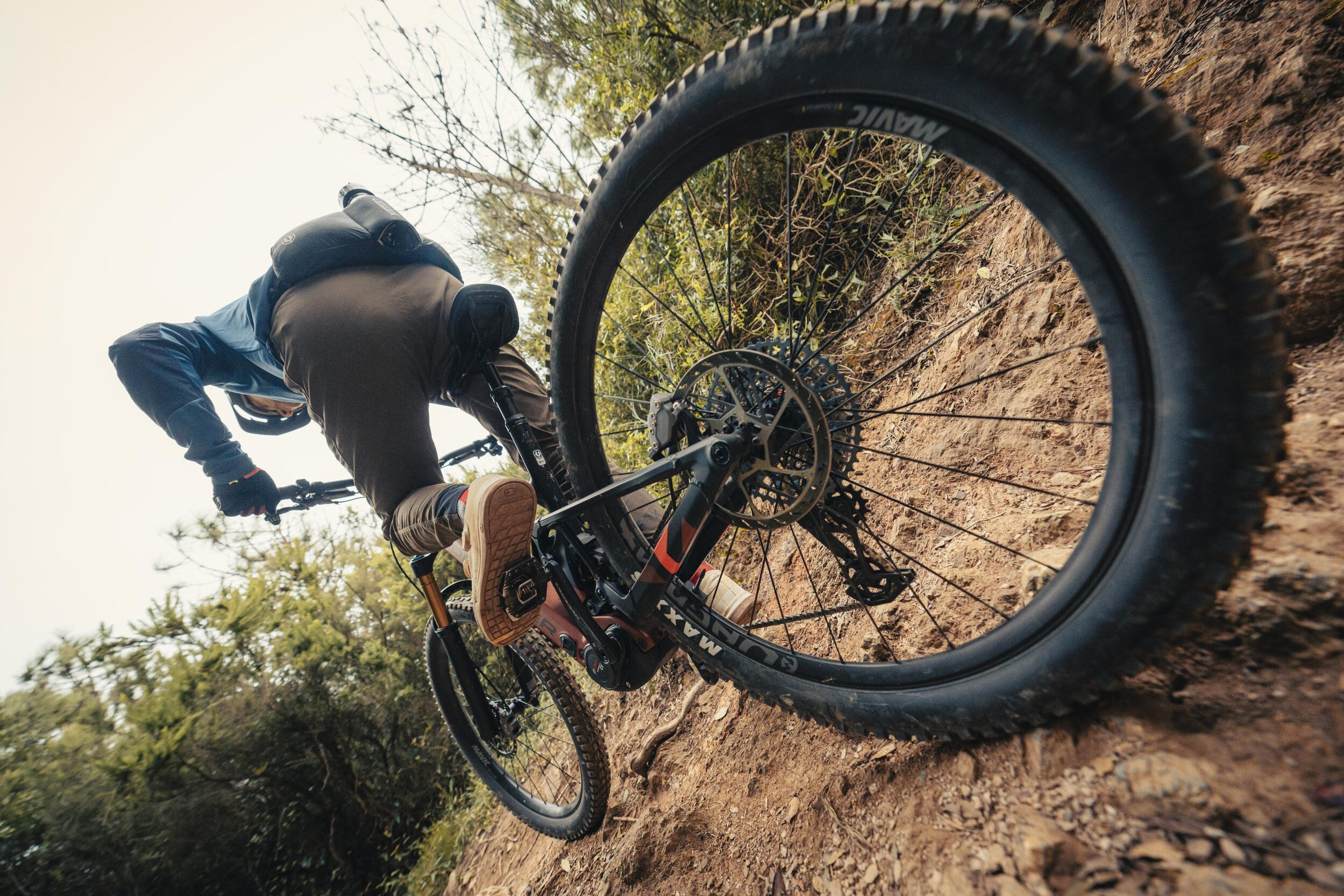
Keeping those wheels turning, with mad grip from a Maxxis Minion DHRII
How we tested the best mountain bike tyres:
For back-to-back testing, all tyres were set up tubeless on modern, wider rims and hammered hard at various spots, both in the UK and abroad. The same bike was used for comparison laps on the same hill, giving direct final analysis between brands. Air pressures were set dependant on casing thickness and suppleness for optimum ride feel for each brand and tyre – mostly around 28psi rear, and 25psi front. Thanks to recent hot spell of weather, we were in the unusual position of not riding one of the newest tyres in the wet, but rain on the before our test completion meant we were able to carry out some 11th hour wet weather testing too.
What do I need to look for in the best mountain bike tyres?
Tyres are a vital piece of kit that connect your bike to the trails. They control everything from cornering grip to braking traction, and rolling speed to cushioning and comfort. These multiple factors can totally transform your ride experience, and can actively keep you safer on a variety of trails and help prevent crashes..
Modern tyres are continually improving, so compound blends, tread patterns, and construction technologies are better than ever, allowing harder riding with less downtime. In fact, if you set up the right tyre tubeless, and you’re prepared to compromise a little on weight, it can deliver huge levels of grip and virtually eliminate cuts or punctures.

Sidewall information centre
How much difference does the rubber compound make?
Rubber hardness is measured by a durometer on the shore scale. Higher numbers signify firmer compounds: 60a is harder and longer lasting than 50a rubber. The secret ingredients and rubber chemistry tyre brands use are something of a mystery and can also make a huge difference to grip, rebound damping and rolling speed. So the answer is that rubber compounds make a significant difference, and you need to decide whether you are prioritising ultimate grip (in wet or dry) or low rolling resistance, along with other factors such as weight, casing stiffness and width.
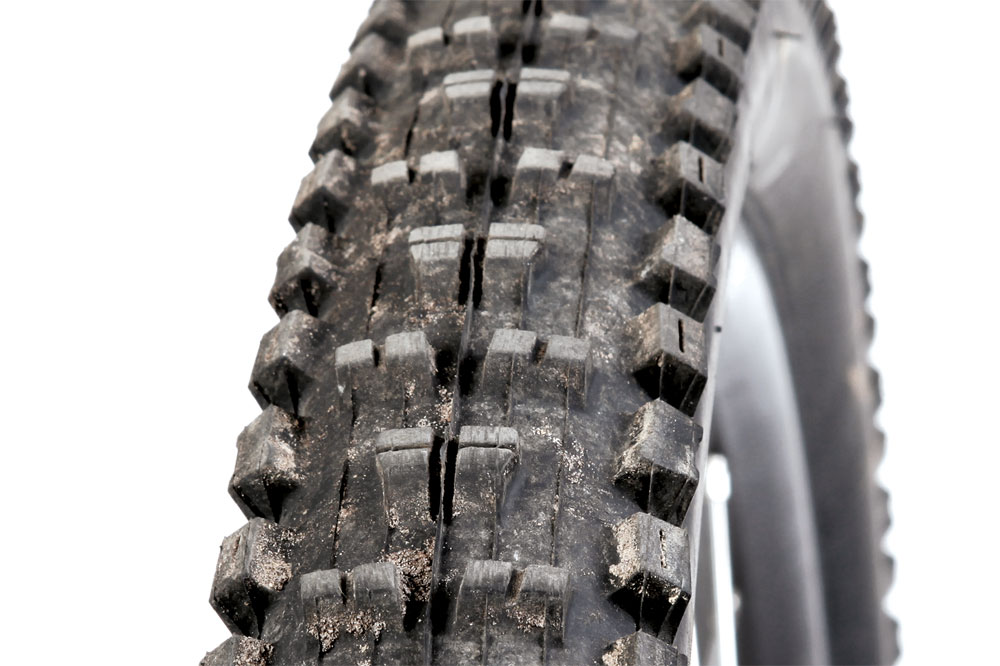
Tread knobblies
What do differences in tyre tread pattern make to performance?
Widely-spaced treads bite better in looser surfaces and clear mud more effectively, but can also increase rolling resistance. Sipes and cuts help braking and the way the tyre deforms to obstacles. A more pronounced channel between shoulder and centre knobs can deliver better off-camber bite and a sensation of ‘railing’ turns, but some riders prefer a more continuous, rounded feel than the on/off grip generated by such a tread gap.

Sizing info, but 60psi is a maximum pressure, not a guide pressure!
What air pressure should I run in my tyres?
Different tyres require specific air pressures. A rough rule of thumb is: the thicker the casing, the lower the air pressure you can get away with. Equally, the bigger the tyre volume, the lower the pressure you can run, and vice versa. For maximum comfort and grip, aim for the minimum pressure that keeps the casing from twisting too much and still prevents rim strikes under impacts. Experiment with lower pressures if you often run over 30psi.
What about casing construction?
Casing thickness and precise ply lay-up has a big impact on ride quality and affects conformity, rolling speed and durability. Harder charging riders might have to accept the extra weight of meatier casings to prevent punctures and stop sidewalls folding under cornering forces. Heavier tyres accelerate more slower, but feel more planted and stable once momentum takes hold. Tubeless is always the way to go – inner tubes feel dead and lifeless, and cause more issues in our experience.
Should I choose a wider or narrower width tyre?
Using wider tyres up front for extra grip and comfort makes good sense. Arms get more cushioning and comfort, and, like skis, narrower rears can help initiate faster turning. Tyre width is directly relative to air volume, and larger volumes provide more isolation, damping and control, up to a point. Wider tyres add weight for climbing and acceleration, but rolling speed between different widths should be so close off-road, it’s not such an issue.
What kind of weight are modern MTB trail tyres?
Wider, more aggressive tyres need lots of support to keep tread blocks stable and use more casing material and rubber, which all adds weight. Bigger, heavier tyres can stabilise the bike by being harder to deflect at speed and larger air volumes offer more isolation from the ground too – especially useful to smooth out rougher terrain on shorter travel rigs. Now, anything under 1,000g is considered relatively light, while over 1,200g is heavy for enduro/trail use.
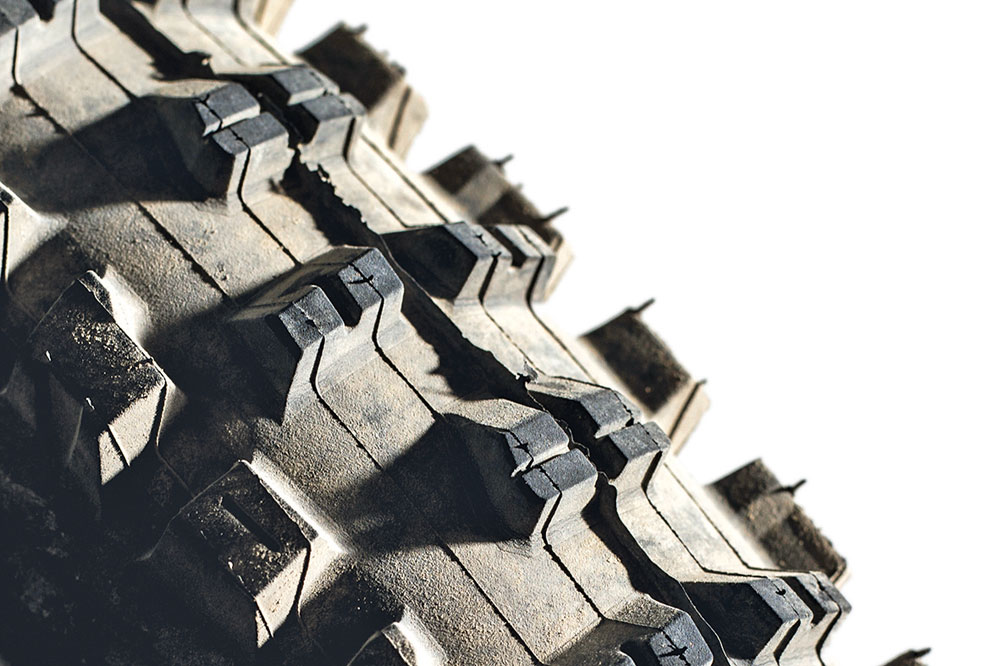
Ramped knobs reduce rolling resistance
Are front specific mountain bike tyres worth considering?
Using wider tyres up front for extra grip and comfort makes a lot of sense. Hands get extra cushioning, and slightly narrower rear tyres can also help initiate faster turning. Tyre width is directly relative to air volume, though, and a larger air volume provides more isolation, damping and control.

A speedy rear tyre can help with pace and energy levels
Are rear specific mountain bike tyres worth considering?
With a faster rolling, lower profile centre strip and pronounced edge blocks for leant-over grip, semi-slick tyres can be a great UK option. This is why we’ve largely resigned full-on XC tyres to history for trail riding. The extra bonus of the slip-to-grip attitude of semi slicks makes them a real hoot in greasier conditions.








